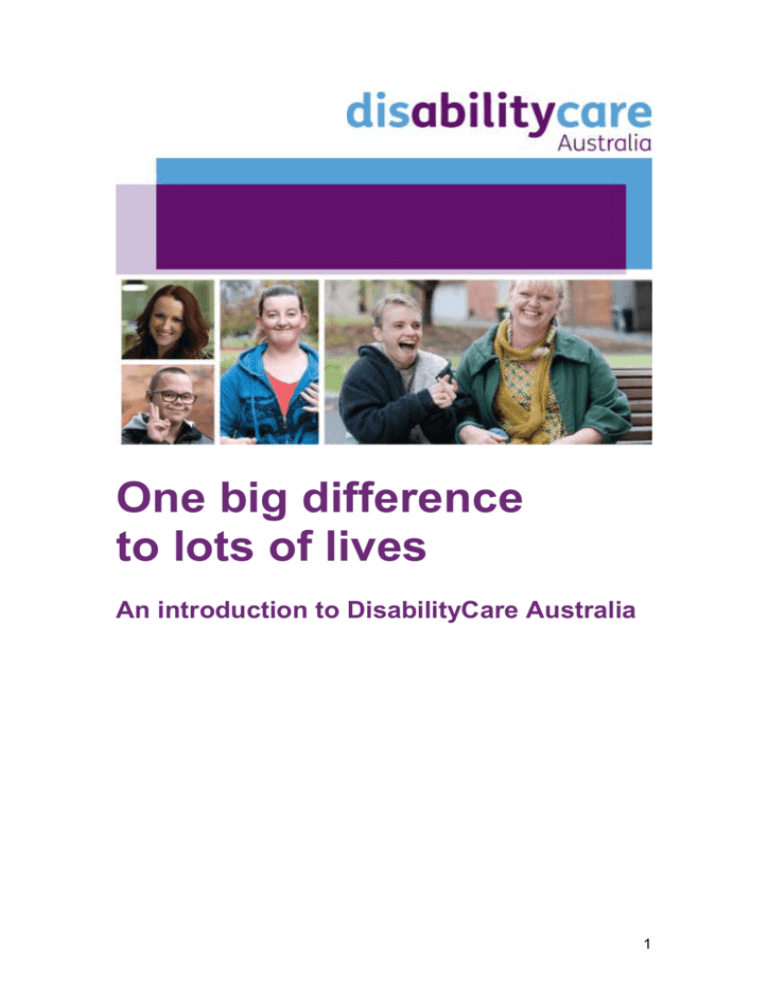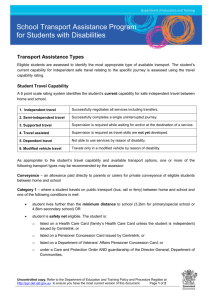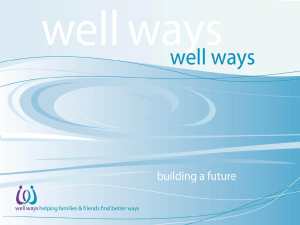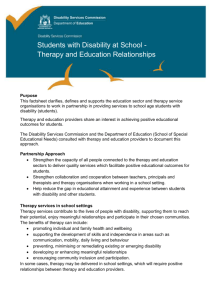
One big difference
to lots of lives
An introduction to DisabilityCare Australia
1
Contents
What is this booklet about?
3
What is DisabilityCare Australia?
3
What do we provide?
3
Where is DisabilityCare Australia available?
4
Who is eligible?
5
How do you check if you are eligible?
5
What is different about our approach?
6
How do we work with people receiving support?
7
How do we work with providers?
7
How do we work with families and carers?
8
What about people outside launch areas?
9
What about people who are 65 or older?
9
What about people who don’t want to change?
9
What do we value?
9
How can people provide feedback?
10
Contact us
10
2
What is this booklet about?
This booklet introduces DisabilityCare Australia, the national disability
insurance scheme, and explains:
what we provide
who we can help
how we work with people with disability, families, carers and providers
where to find more information.
What is DisabilityCare Australia?
DisabilityCare Australia is a new way of providing community linking and
individualised support for people with permanent and significant disability,
their families and carers. It provides choice and control and a whole-of-life
approach to the support needed for people to live more independently and
work towards achieving their goals.
DisabilityCare Australia is the insurance that gives us all peace of mind to
know that, if necessary, we can have the support that is right for us.
‘I’m looking for a scheme that is flexible and realistic about what people with
disabilities actually need to live a good life.’ (George)
What do we provide?
We understand that everyone’s needs, preferences and aspirations are
different.
That’s why we provide to eligible people a flexible, whole-of-life approach to
the support needed to pursue their goals and aspirations and participate in
daily life.
We provide information and referrals
Anyone with or affected by disability can ask us for information and referrals,
including the families and carers of people with disability.
Through this service we:
provide easier and better access to information about the most effective
support options
refer people to relevant disability, mainstream and community services
and supports
refer people to supports to help build their individual capacity through
activities such as peer support and skills development
link people with local support groups, clubs, associations, initiatives or
programs.
3
We help people plan their individualised support
We help DisabilityCare Australia participants develop individual support plans
that can include mainstream, community, informal and reasonable and
necessary funded supports such as:
one-off supports, for example equipment
personal support for daily living
early intervention services
local area coordination
supports to achieve greater independence and community
participation.
Individual support plans
Individual support plans provide people with choice and control over the
support they receive. A plan may include familiar supports, such as help with
certain activities or aids and equipment to maximise mobility and
independence. Supports may be more flexible and innovative, based on a
person’s needs, goals, aspirations and family environment. Importantly,
support plans will make sure the valuable support provided by families and
carers can be sustained.
We build community awareness and capacity
We aim to improve community awareness of the issues that affect the social
and economic participation of people with disability, and build the community’s
capacity to make it easier for them to participate in everyday life.
All Australians can access general information about disability supports in the
community through our website, our offices in launch areas, and by phone
through our information line. We will also develop close working relationships
with other key supports in the community such as social, health, business and
regional networks.
Where is DisabilityCare Australia
available?
We are introducing DisabilityCare Australia in stages from July 2013. This is
because it’s a big change, and we want to get it right and make it sustainable.
From 1 July 2013, DisabilityCare Australia begins in:
the Hunter area of New South Wales for people up to age 65
the Barwon area of Victoria for people up to age 65
South Australia for children aged 0 to 14
Tasmania for youth aged 15 to 24.
From 1 July 2014, DisabilityCare Australia will start in the Australian Capital
Territory, and the Barkly region of the Northern Territory.
4
We will progressively roll out the full scheme from July 2016, including across
Queensland.
More information about where and when DisabilityCare Australia is available
is on our website at disabilitycareaustralia.gov.au
Who is eligible?
If you want information or need a referral
Anyone with or affected by disability, including families and carers, can
contact us for information and referrals. More information about contacting us
is on page 19.
If you need an individual support plan
You may be able to receive an individual support plan if:
you are under 65 years of age
you are an Australia citizen, a permanent resident, or New Zealand
citizen who is a Protected Special Category Visa holder
during the first stage of the scheme, you live in a launch area and meet
the specific age requirements for that area (see page 7).
You also need to meet the disability requirements:
you have a permanent impairment and
you cannot join in activities or do things without assistive technology,
equipment (other than commonly used items like glasses) or home
modifications or
you usually require help from others to join in or do things.
Or you need to meet the early intervention requirements:
you or your child have a disability that is likely to be permanent or
your child has a developmental delay and
there is evidence that shows getting early supports will reduce how
much help you or your child need to do things in the future.
How do you check if you are eligible?
To find out what is available to you, you can:
use My Access Checker
phone us on 1800 800 110 or
visit one of our offices in a launch area.
Some people’s existing supports will move across to us automatically. Your
provider will tell you if this applies to you. If you are not sure about this,
contact us.
5
My Access Checker
My Access Checker is a tool to help you understand whether you may be able
to access individualised assistance from DisabilityCare Australia. If possible,
you should complete My Access Checker before contacting us. We can help
you to use it if needed.
If My Access Checker shows you may be able to access individualised
assistance, contact us to discuss your circumstances and to complete
an access request form. We will then work with you to develop your
individual plan.
If My Access Checker shows you may not be able to access
individualised assistance, you can still contact us—even if we can’t
provide you with an individual support plan, we can still provide
information.
You can use My Access Checker on our website at
disabilitycareaustralia.gov.au or you can ask us for a paper version.
What is different about our approach?
We work with people to identify their goals, we provide information and
referrals, and we can arrange for individualised supports to enable people to
achieve a better quality of life and increased social and economic
participation.
Our approach:
Empowers and enables—People with disability are at the centre of
decision-making about their lives and connected to supports that best
suit their individual circumstances.
Increases choice and control—People have more flexibility to choose
support options. They have more control over how, when and where
they receive support. This includes choosing how much they want to
control the management of any funding, who supports them and how.
Suits individual circumstances—People receive the reasonable and
necessary supports they need to pursue their goals, be more
independent, and participate in the community.
Takes a lifetime view—Planning looks beyond immediate need to
what is required across someone’s lifetime. This includes goals and
aspirations, living arrangements, informal supports and carer’s
circumstances. This also includes making early investments where this
will reduce support needs and costs over someone’s lifetime. Support
arrangements can be changed as goals, preferences and needs
change over time.
Spreads the cost—By spreading the cost among the wider
community, we can make sure the scheme is sustainable into the
future.
6
How do we work with people receiving
support?
Our planners
Our planners come from a broad range of backgrounds, and have the
expertise, training and skills to support DisabilityCare Australia participants.
They help people work out their goals and plan what support they need to
pursue them.
Our local area coordinators
Our coordinators know their communities. They support community and
mainstream services to welcome, and increase participation options for,
people with disability.
They support communities to increase meaningful participation of people with
disability. Coordinators can help people to develop goals and how they might
be achieved—this might involve building new networks and information about
how to access community supports and services. They also keep in touch
with participants to see how their plans and supports are going.
Existing arrangements
After having a planning conversation with us, DisabilityCare Australia
participants can choose to keep their existing supports if they are happy with
the supports provided. Or we can work with them to adjust their supports to
better meet their needs.
How do we work with providers?
Register with us
People using the scheme choose their supports and how they are provided
based on their individual plan. They also choose whether to manage their plan
themselves or through a nominee, registered plan management provider, or
through us at DisabilityCare Australia. Where we manage the plan funding,
providers must register with us to claim payments for the supports they
provide. Providers and plan management providers need to register through
our website. Go to disabilitycareaustralia.gov.au and click on the ‘Providers’
tab.
Gradual transition
Agreements with state and territory governments spell out which programs
they fund and how and when these programs will change over to
DisabilityCare Australia. During the launch stage, some existing block grant or
case-based funding arrangements stay the same, while some funding moves
to individual support plans. Programs may either convert to cash contributions
or gradually change to fee-for-service arrangements purchased through an
individual’s plan.
7
Descriptions of the timing for people to move into DisabilityCare Australia in
each launch site are available at disabilitycareaustralia.gov.au/fact-sheetsand-publications
What providers can tell existing clients
Providers’ existing clients don’t need to do anything right now. Their current
support arrangements will continue until they move across to DisabilityCare
Australia, in accordance with the agreed phasing rules that govern the timing
for people to move into DisabilityCare Australia in each launch site.
We are supporting the sector
We are providing information and tools to help providers offer supports to
people, adjust how they work with people, and be part of this new way of
doing things.
We are also funding projects that improve the capacity of the sector, develop
new and different support opportunities, and share information about better
practices and lessons learnt.
‘I’m passionate about advocating for people living with a disability.’ (Louise)
How do we work with families and carers?
We recognise the valued role of families and carers who support people with
disability. We will take informal supports into account when we design the
plan with a participant.
We work with families and carers to help make sure the informal support they
give can be sustained. We also recognise that some people with disability
may want the support of family members, carers and others to make informed
decisions.
Who provides informal support?
Informal care is often provided by someone who, without pay, supports a
family member, friend or neighbour who needs assistance with daily activities.
What support do we provide carers and families?
We consider carers in individual plans—We consider the carer’s
role and circumstances when developing plans with participants. For
example, the type and intensity of support provided, other care
responsibilities and work or study commitments. We also consider the
impact on other family members.
We can involve carers in planning—We recognise the value of
including the carer’s views, knowledge and experience in support
planning. How involved the carer is in the planning process depends on
things like the age, wishes and needs of the person with disability, and
whether the carer has any legal decision-making authority.
We help ensure sustainable care arrangements—We talk to carers
about whether they need assistance to continue the same level of care,
8
what may affect their capacity to continue providing care into the future,
whether there are other carers who may also provide support, and the
carer’s own life plans and aspirations. For example, as part of an
individual plan we may provide funding to help carers, such as for
training in support techniques or family capacity building. We know the
support given may need to be reviewed as circumstances and
aspirations change, for both the carer and the person they care for.
We provide information and referral—Our comprehensive
information and referral services help families and carers to access
disability, community and other supports such as courses to build
resilience and networks, counselling, peer support programs and
education.
‘I want my sister to access the community in ways that everybody does.’
(Alison)
What about people outside launch areas?
For people living outside the first launch areas, existing national and statebased services and supports will continue until DisabilityCare Australia is
introduced in their area or extended to their age group.
The work in launch areas will help us make sure we get implementation right
and have a sustainable system that provides greater equity and ongoing
access for people if they move to another part of Australia.
What about people who are 65 or older?
The aged care system supports people who are 65 or older. People who start
with DisabilityCare Australia when they are under 65 can choose to stay in the
scheme or move to the aged care system once they turn 65 (or 50 for
Indigenous Australians).
What about people who don’t want to
change?
People may choose to keep their existing supports if they are happy with their
arrangements and if they are appropriate to their needs. We will work with
people to understand their needs.
What do we value?
Our guiding principles
We believe people with disability have the same right as others to develop,
pursue their goals, participate in society, have respect and dignity, exercise
9
choice and control, be equal partners in decisions that affect their lives, and
be certain they will receive the support they need over their life.
Our service commitment
We will provide professional, high quality, accessible, fair and timely service.
You can expect respect, choice, control, flexibility, understanding, clear and
accurate information and responsive service.
Our values
Our core values are behind everything we do. They are responsiveness,
respect, transparency, accountability, innovation and learning.
Your privacy
We protect the privacy of people we work with. We follow national guidelines
for collecting, using and disclosing personal information.
How can people provide feedback?
We welcome your feedback
Please tell us if we have provided a good service or helped you. You can give
feedback direct to the person you are dealing with or email us at
feedback@disabilitycareaustralia.gov.au or call 1800 800 110.
We want to know if you have a concern
We believe people have the right to raise a concern or make a complaint. This
helps us see what is not working and how our service can be improved.
We will do our best to resolve your concerns as soon as possible. If you are
unhappy with our service please raise the issue straight away with the person
you are dealing with. If this is not appropriate or does not help, you can ask to
speak with that person’s supervisor or the state/territory manager.
You can make a complaint in person, by phone, email or letter to the office
you are dealing with. Contact details are below.
Contact us
Visit our website
disabilitycareaustralia.gov.au
Call us on 1800 800 110
Monday to Friday, 8.00am to 8.00pm Eastern Standard Time
TTY users phone 1800 555 677 and ask for 1800 800 110
Speak and Listen users phone 1800 555 727 and ask for 1800 800 110
10
Internet relay users, connect to the National Relay Service at
relayservice.com.au and ask for 1800 800 110
Write to us
GPO Box 700, Canberra ACT 2601
Visit us
Details about our office locations are on our website.
Do you need help to meet with us?
If you want to meet with us but need help, call us on 1800 800 110.
Do you speak a language other than English?
If you do not speak English, please call the Translating and Interpreting
Service on 131 450 and ask to be connected to 1800 800 110.
© Commonwealth of Australia 2013
This work is copyright. You may reproduce the whole or part of this work in
unaltered form for your own personal use or, if you are part of an organisation,
for internal use within your organisation, but only if you or your organisation
do not use the reproduction for any commercial purpose and retain this
copyright notice and all disclaimer notices as part of that reproduction. Apart
from rights to use as permitted by the Copyright Act 1968 or allowed by this
copyright notice, all other rights are reserved and you are not allowed to
reproduce the whole or any part
of this work in any way (electronic or otherwise) without first being given the
specific written permission from the Commonwealth to do so.
For more information and to submit requests or enquiries, go to
disabilitycareaustralia.gov.au/copyright
FAHCSIA12704–1JULY2013
11









